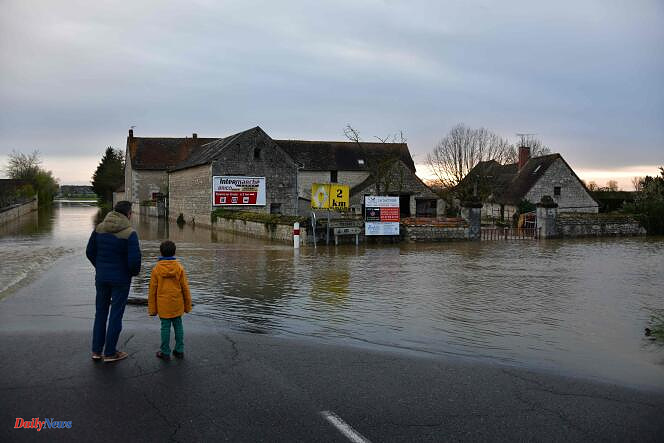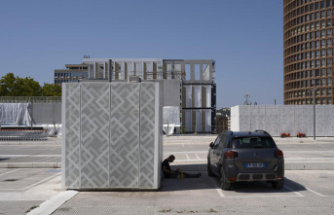Numerous evacuations have taken place or are in progress in Indre-et-Loire and Vienne, due to the severe river flooding which has occurred since Saturday March 30 in the center-west of the country. A kayaker is still needed.
The alert was given on Saturday around 4 p.m. by several witnesses who saw the kayaker “in difficulty” from the town of Aixe-sur-Vienne (Haute-Vienne), 10 kilometers west of Limoges. “They judged from afar that he had difficulty controlling. It was from there that searches were launched over around ten kilometers, the secretary general of the Haute-Vienne prefecture, Laurent Monbrun, explained to Agence France-Presse (AFP). Like the day before, the searches carried out on Sunday "up to the border with Charente" by the gendarmerie, with a helicopter in support, yielded nothing, the prefecture said. They will resume Monday morning, in an area now in decline and without particular vigilance.
Further north, Indre-et-Loire remains classified on red alert for Monday, and Vienne was reclassified on Sunday evening, on orange alert by Météo-France. In these three departments – Haute-Vienne, Vienne and Indre-et-Loire – the government has launched “the accelerated procedure for recognition of the state of natural disaster”, announced Sunday evening, Mr. Darmanin , on X.
In total, the floods of the Creuse and the Vienne affect 34 municipalities, which have deployed their municipal protection plan. In total throughout the Central-West zone, more than 450 firefighters were mobilized and around thirty roads were flooded, according to a police source.
The 2007 flood likely to be exceeded in Indre-et-Loire
In Indre-et-Loire, several hundred people were being evacuated on Sunday evening in a suburb of Chinon and in the surrounding villages in anticipation of the rising waters of the Vienne. “Extremely serious alert (…) Leave your home after shutting off the water, gas and electricity,” residents could read on their cell phones.
At the same time, dozens of fire trucks were stationed on the Danton quay, on the banks of the swollen Vienne, and on the road bridge which connects the city center to the Faubourg Saint-Jacques, on the opposite bank, noted a AFP journalist. In total, “750 people would potentially be affected by preventive evacuations linked to rising water levels in the areas of Chinon, Savigny-en-Véron, Beaumont-en-Véron and Saint-Germain-sur-Vienne,” the prefecture announced. of Indre-et-Loire a little earlier in a press release.
Two emergency accommodation centers, a gymnasium and a leisure center, “will be armed by civil security associations,” she said, while 150 gendarmes and firefighters are still specifically engaged on the crisis.
The peaks of the flood are likely to occur on Monday between 3 a.m. and 5 a.m., in Chinon, with a predictable height of 5.30 m to 5.62 m, which could exceed the flood of March 2007 (5.39 m). Sunday evening, at 10 p.m., the Vienne rose to 5.24 m, almost touching the arches of the bridge, carrying away several tree trunks in its passage, noted an AFP journalist.
“There wasn’t the intensity we feared.”
Until Sunday evening, the evacuations had only concerned 154 people in the department, including 73 residents of an nursing home in the town of L'Île-Bouchard, on the banks of Vienne.
Upstream, in Nouâtre, a town of 900 inhabitants, the water rose more than six meters in 36 hours, exceeding the level reached on January 8, 1982. Further north, on the Creuse River, the water even rose up to 7.34 m at Descartes, above the flood of March 4, 1923.
The floods are currently less severe than feared on Saturday evening. “There was damage, but ultimately, there was not the intensity that we feared,” explained the prefect of Indre-et-Loire, Patrice Latron, during a press conference. The prefecture nevertheless warns against “phenomena of rupture or overflowing of dikes” and of the dangerousness of “zones below ground, in particular underground car parks”.
In Vienne, the Creuse river reached 6.78 meters at Roche-Posay, exceeding the historic flood of 1982. It should rise again at the end of the morning and approach the record of 1896, explained a Vigicrues technician on site to the AFP.
“For me, it’s the flood of the century”
The water rushed into several houses located on the banks, without reaching the city center, located higher up. “I have lived in La Roche-Posay since the 1960s, I have never seen this. For me, it’s the flood of the century. The racecourse was already flooded at the edge, but there it became a lake,” testified Jean-Louis Olivier, president of the racing society, in front of the racecourse completely swallowed up by the river.
“Following the severe weather of the last two days, Creuse, Gartempe and Vienne reached exceptional height peaks linked to rainfall of 100 mm in two days, the equivalent of two months of rain,” said the prefecture. of Vienna in a press release.
In this department, 150 firefighters and gendarmes are mobilized, and around ten roads have been cut by the rising waters, the prefecture said. The drinking water network was cut off in three municipalities in the south of Vienne after the floods the day before. Three municipalities were “in difficulty” in Indre-et-Loire on Sunday. Drinking water distributions are organized.
On the Creuse River, “we are beyond the ten-year flood. I don’t yet know if we can talk about a 100-year flood,” declared the prefect of Indre-et-Loire.
Four departments on orange alert
In Indre, currently placed on yellow alert for floods and storms, the prefecture announced in a press release on Sunday morning: “The situation has improved, but vigilance is required. » If the sections of the Creuse median and the Indre upstream “are in a recession phase” announces the prefecture, “thirty-seven homes still remain without electricity”, she specifies.
In addition, Météo-France has also placed the departments of Charente, Charente-Maritime, Gironde and Dordogne on orange “flood” alert. Haute-Vienne is no longer concerned.
Orange “avalanche” vigilance was launched in the Alpes-de-Haute-Provence and in the Alpes-Maritimes for the Mercantour massif, from Sunday afternoon. “The most intense rainfall is expected Sunday evening and the following night. Avalanches have already been reported on the Isola 2000 road,” Météo-France reported on Sunday. The road leading to this ski resort in the Southern Alps, whose season was due to end on April 14, was closed on Sunday, in both directions, “for an indefinite period,” explained the Nice metropolis in a press release.












